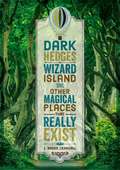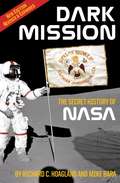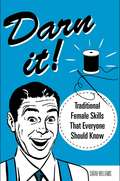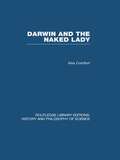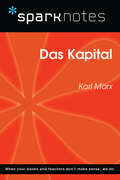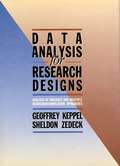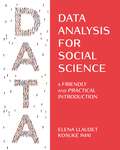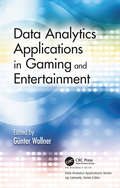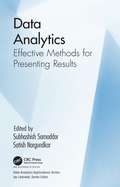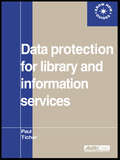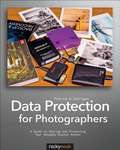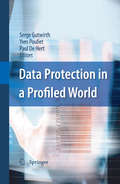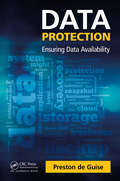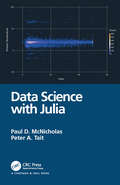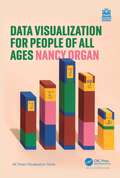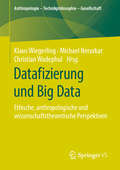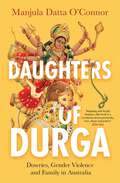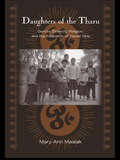- Table View
- List View
Dark Hedges, Wizard Island, and Other Magical Places That Really Exist
by L Rader CrandallFrom a lost city in the desert to a cave alight with thousands of glowworms, learn about some of the most unusual places on earth and the myths, legends, and history behind each of them!Looking at places like The Skeleton Coast in Namibia, Wizard Island in the United States, and The Fairy Tale Route in Germany, The Dark Hedges and Other Magical Places that Really Exist takes young readers on a journey around the world to real places that sound straight out of fantasy. Featuring both natural and man-made wonders, this travel book combines history and storytelling to explore the far reaches of the earth.
Dark Mission
by Richard C. Hoagland Mike BaraThe New York Times bestseller about the strange history of NASA and its cover-ups regarding its origins and extraterrestrial architecture found on the moon and Mars is even more interesting in its new edition.Authors Richard C. Hoagland and Mike Bara include a new chapter about the discoveries made by ex-Nazi scientist and NASA stalwart Wernher von Braun regarding what he termed "alternate gravitational solutions," or the rewriting of Newtonian physics into hyperdimensional spheres.
Darn It!: Traditional Female Skills That Everyone Should Know
by WilliamsCan you sew on a button? Or wrap a present? Worry not—Darn It! is here to help you master such tasks with ease to expand your repertoire and skill set, making you a more well-rounded, twenty-first-century man. Easy to navigate, this instruction manual helps you take matters into your own hands. There’s no shame in knitting your own scarf or hat, especially if it means achieving complete self-reliance. The tips and instructions in this book will teach you how to: Iron a shirt Clean your silverware Apply a bandage Use a sewing machine Make an omelet And much more! Beautifully illustrated, with clear and concise step-by-step instructions, this essential handbook is the ultimate survival guide for the modern man.
Darwin and the Naked Lady: Discursive Essays on Biology and Art (Routledge Library Editions: History & Philosophy of Science)
by Alex ComfortOriginally published in 1961. The essays in this volume focus on the awareness of science and art, evolution and Freudian psychology. Besides the chapter on Darwin and Freud, the author discusses criticism, the fantasy element in drama and popular literature, the history of the novel, the motivation of science and the function of erotic art.
Darwinism and the Study of Society: A centenary symposium
by Michael BantonTavistock Press was established as a co-operative venture between the Tavistock Institute and Routledge & Kegan Paul (RKP) in the 1950s to produce a series of major contributions across the social sciences. This volume is part of a 2001 reissue of a selection of those important works which have since gone out of print, or are difficult to locate. Published by Routledge, 112 volumes in total are being brought together under the name The International Behavioural and Social Sciences Library: Classics from the Tavistock Press. Reproduced here in facsimile, this volume was originally published in 1961 and is available individually. The collection is also available in a number of themed mini-sets of between 5 and 13 volumes, or as a complete collection.
Das Buch Henoch
by A. G. HoffmanAn ancient Jewish religious work, ascribed by tradition to Enoch, the great-grandfather of Noah, although modern scholars estimate the older sections (mainly in the Book of the Watchers) to date from about 300 BC, and the latest part (Book of Parables) probably to the first century BC.
Das Ende der Demokratie?
by Volker Boehme-NeßlerWie verändert sich die Demokratie durch die Digitalisierung? Dieser Frage geht das Buch aus verfassungsrechtlicher, technikrechtlicher, politikwissenschaftlicher und psychologischer Sicht nach. Dazu arbeitet es zunächst die Charakteristika von Digitalisierung heraus. Es fragt, wie sich die Digitalisierung auf das Denken, das Verhalten und die (politische) Kommunikation auswirkt. Auf dieser Grundlage vertritt der Autor die These, dass sich die Demokratie grundlegend verändern muss und wird. Im letzten Teil skizziert er, wie die Demokratie konkret im digitalen Zeitalter funktionieren könnte.
Das Kapital (SparkNotes Philosophy Guide)
by SparkNotesDas Kapital (SparkNotes Philosophy Guide) Making the reading experience fun! SparkNotes Philosophy Guides are one-stop guides to the great works of philosophy–masterpieces that stand at the foundations of Western thought. Inside each Philosophy Guide you&’ll find insightful overviews of great philosophical works of the Western world.
Data Analysis for Physical Scientists
by Les KirkupThe ability to summarise data, compare models and apply computer-based analysis tools are vital skills necessary for studying and working in the physical sciences. This textbook supports undergraduate students as they develop and enhance these skills. Introducing data analysis techniques, this textbook pays particular attention to the internationally recognised guidelines for calculating and expressing measurement uncertainty. This new edition has been revised to incorporate Excel® 2010. It also provides a practical approach to fitting models to data using non-linear least squares, a powerful technique which can be applied to many types of model. Worked examples using actual experimental data help students understand how the calculations apply to real situations. Over 200 in-text exercises and end-of-chapter problems give students the opportunity to use the techniques themselves and gain confidence in applying them. Answers to the exercises and problems are given at the end of the book.
Data Analysis for Research Designs: Analysis of Variance and Multiple Regression/Correlation Approaches
by Geoffrey Keppel Sheldon ZedeckData Analysis for Research Designs covers the analytical techniques for the analysis of variance (ANOVA) and multiple regression/correlation (MRC), emphasizing single-degree-of-freedom comparisons so that students focus on clear research planning. This text is designed for advanced undergraduates and graduate students of the behavioral and social sciences who have an understanding of algebra and statistics.
Data Analysis for Social Science: A Friendly and Practical Introduction
by Kosuke Imai Elena LlaudetAn ideal textbook for complete beginners—teaches from scratch R, statistics, and the fundamentals of quantitative social scienceData Analysis for Social Science provides a friendly introduction to the statistical concepts and programming skills needed to conduct and evaluate social scientific studies. Assuming no prior knowledge of statistics and coding and only minimal knowledge of math, the book teaches the fundamentals of survey research, predictive models, and causal inference while analyzing data from published studies with the statistical program R. It teaches not only how to perform the data analyses but also how to interpret the results and identify the analyses&’ strengths and limitations.Progresses by teaching how to solve one kind of problem after another, bringing in methods as needed. It teaches, in this order, how to (1) estimate causal effects with randomized experiments, (2) visualize and summarize data, (3) infer population characteristics, (4) predict outcomes, (5) estimate causal effects with observational data, and (6) generalize from sample to population.Flips the script of traditional statistics textbooks. It starts by estimating causal effects with randomized experiments and postpones any discussion of probability and statistical inference until the final chapters. This unconventional order engages students by demonstrating from the very beginning how data analysis can be used to answer interesting questions, while reserving more abstract, complex concepts for later chapters.Provides a step-by-step guide to analyzing real-world data using the powerful, open-source statistical program R, which is free for everyone to use. The datasets are provided on the book&’s website so that readers can learn how to analyze data by following along with the exercises in the book on their own computer.Assumes no prior knowledge of statistics or coding.Specifically designed to accommodate students with a variety of math backgrounds. It includes supplemental materials for students with minimal knowledge of math and clearly identifies sections with more advanced material so that readers can skip them if they so choose.Provides cheatsheets of statistical concepts and R code.Comes with instructor materials (upon request), including sample syllabi, lecture slides, and additional replication-style exercises with solutions and with the real-world datasets analyzed. Looking for a more advanced introduction? Consider Quantitative Social Science by Kosuke Imai. In addition to covering the material in Data Analysis for Social Science, it teaches diffs-in-diffs models, heterogeneous effects, text analysis, and regression discontinuity designs, among other things.
Data Analytics Applications in Gaming and Entertainment (Data Analytics Applications)
by Günter WallnerThe last decade has witnessed the rise of big data in game development as the increasing proliferation of Internet-enabled gaming devices has made it easier than ever before to collect large amounts of player-related data. At the same time, the emergence of new business models and the diversification of the player base have exposed a broader potential audience, which attaches great importance to being able to tailor game experiences to a wide range of preferences and skill levels. This, in turn, has led to a growing interest in data mining techniques, as they offer new opportunities for deriving actionable insights to inform game design, to ensure customer satisfaction, to maximize revenues, and to drive technical innovation. By now, data mining and analytics have become vital components of game development. The amount of work being done in this area nowadays makes this an ideal time to put together a book on this subject. Data Analytics Applications in Gaming and Entertainment seeks to provide a cross section of current data analytics applications in game production. It is intended as a companion for practitioners, academic researchers, and students seeking knowledge on the latest practices in game data mining. The chapters have been chosen in such a way as to cover a wide range of topics and to provide readers with a glimpse at the variety of applications of data mining in gaming. A total of 25 authors from industry and academia have contributed 12 chapters covering topics such as player profiling, approaches for analyzing player communities and their social structures, matchmaking, churn prediction and customer lifetime value estimation, communication of analytical results, and visual approaches to game analytics. This book’s perspectives and concepts will spark heightened interest in game analytics and foment innovative ideas that will advance the exciting field of online gaming and entertainment.
Data Analytics: Effective Methods for Presenting Results (Data Analytics Applications)
by Subhashish Samaddar Satish NargundkarIf you are a manager who receives the results of any data analyst’s work to help with your decision-making, this book is for you. Anyone playing a role in the field of analytics can benefit from this book as well. In the two decades the editors of this book spent teaching and consulting in the field of analytics, they noticed a critical shortcoming in the communication abilities of many analytics professionals. Specifically, analysts have difficulty in articulating in business terms what their analyses showed and what actionable recommendations were made. When analysts made presentations, they tended to lapse into the technicalities of mathematical procedures, rather than focusing on the strategic and tactical impact and meaning of their work. As analytics has become more mainstream and widespread in organizations, this problem has grown more acute. Data Analytics: Effective Methods for Presenting Results tackles this issue. The editors have used their experience as presenters and audience members who have become lost during presentation. Over the years, they experimented with different ways of presenting analytics work to make a more compelling case to top managers. They have discovered tried and true methods for improving presentations, which they share. The book also presents insights from other analysts and managers who share their own experiences. It is truly a collection of experiences and insight from academics and professionals involved with analytics. The book is not a primer on how to draw the most beautiful charts and graphs or about how to perform any specific kind of analysis. Rather, it shares the experiences of professionals in various industries about how they present their analytics results effectively. They tell their stories on how to win over audiences. The book spans multiple functional areas within a business, and in some cases, it discusses how to adapt presentations to the needs of audiences at different levels of management.
Data Protection for Library and Information Services
by Paul TicherThe 1998 Data Protection Act provides a framework for the way in which organisations should collect and process personal information. It has far-reaching implications for library and information managers who hold personal data on computer or on paper, or who may be called on to advise their colleagues. This practical guide explains the legal requirements and illustrates the issues with dozens of relevant and informative case-studies.
Data Protection for Photographers
by Patrick H. CorriganAll photographers, both amateur and professional, are faced with the important issues of data protection and storage. Without knowledge of the options, tools, and procedures for safe and effective image protection and storage, photographers run the serious risk of losing their image files. This book offers critical information about the best hardware, software, procedures, and practices for capturing, storing, and preserving images and other data. This book explains current data protection and storage technologies in everyday terms. It describes effective procedures for protecting data, from capture to backup and archiving. Descriptions of specific products applicable to Windows, MacOS, and Linux systems are provided.
Data Protection in a Profiled World
by Paul De Hert Yves Poullet Serge GutwirthOne of the most challenging issues facing our current information society is the accelerating accumulation of data trails in transactional and communication systems, which may be used not only to profile the behaviour of individuals for commercial, marketing and law enforcement purposes, but also to locate and follow things and actions. Data mining, convergence, interoperability, ever- increasing computer capacities and the extreme miniaturisation of the hardware are all elements which contribute to a major contemporary challenge: the profiled world. This interdisciplinary volume offers twenty contributions that delve deeper into some of the complex but urgent questions that this profiled world addresses to data protection and privacy. The chapters of this volume were all presented at the second Conference on Privacy and Data Protection (CPDP2009) held in Brussels in January 2009 (www.cpdpconferences.org). The yearly CPDP conferences aim to become Europe's most important meeting where academics, practitioners, policy-makers and activists come together to exchange ideas and discuss emerging issues in information technology, privacy and data protection and law. This volume reflects the richness of the conference, containing chapters by leading lawyers, policymakers, computer, technology assessment and social scientists. The chapters cover generic themes such as the evolution of a new generation of data protection laws and the constitutionalisation of data protection and more specific issues like security breaches, unsolicited adjustments, social networks, surveillance and electronic voting. This book not only offers a very close and timely look on the state of data protection and privacy in our profiled world, but it also explores and invents ways to make sure this world remains a world we want to live in.
Data Protection: Ensuring Data Availability
by Preston de GuiseThis is the fundamental truth about data protection: backup is dead. Or rather, backup and recovery, as a standalone topic, no longer has relevance in IT. As a standalone topic, it’s been killed off by seemingly exponential growth in storage and data, by the cloud, and by virtualization. So what is data protection? This book takes a holistic, business-based approach to data protection. It explains how data protection is a mix of proactive and reactive planning, technology and activities that allow for data continuity. It shows how truly effective data protection comes from a holistic approach considering the entire data lifecycle and all required SLAs. Data protection is neither RAID nor is it continuous availability, replication, snapshots or backups—it is all of them, combined in a considered and measured approach to suit the criticality of the data and meet all the requirements of the business. The book also discusses how businesses seeking to creatively leverage their IT investments and to drive through cost optimization are increasingly looking at data protection as a mechanism to achieve those goals. In addition to being a type of insurance policy, data protection is becoming an enabler for new processes around data movement and data processing. This book arms readers with information critical for making decisions on how data can be protected against loss in the cloud, on-premises, or in a mix of the two. It explains the changing face of recovery in a highly virtualized data center and techniques for dealing with big data. Moreover, it presents a model for where data recovery processes can be integrated with IT governance and management in order to achieve the right focus on recoverability across the business.
Data Science and Risk Analytics in Finance and Insurance (Chapman and Hall/CRC Financial Mathematics Series)
by Tze Leung Lai Haipeng XingThis book presents statistics and data science methods for risk analytics in quantitative finance and insurance. Part I covers the background, financial models, and data analytical methods for market risk, credit risk, and operational risk in financial instruments, as well as models of risk premium and insolvency in insurance contracts. Part II provides an overview of machine learning (including supervised, unsupervised, and reinforcement learning), Monte Carlo simulation, and sequential analysis techniques for risk analytics. In Part III, the book offers a non-technical introduction to four key areas in financial technology: artificial intelligence, blockchain, cloud computing, and big data analytics.Key Features: Provides a comprehensive and in-depth overview of data science methods for financial and insurance risks. Unravels bandits, Markov decision processes, reinforcement learning, and their interconnections. Promotes sequential surveillance and predictive analytics for abrupt changes in risk factors. Introduces the ABCDs of FinTech: Artificial intelligence, blockchain, cloud computing, and big data analytics. Includes supplements and exercises to facilitate deeper comprehension.
Data Science with Julia
by Peter Tait Paul McNicholas"This book is a great way to both start learning data science through the promising Julia language and to become an efficient data scientist."- Professor Charles Bouveyron, INRIA Chair in Data Science, Université Côte d’Azur, Nice, France Julia, an open-source programming language, was created to be as easy to use as languages such as R and Python while also as fast as C and Fortran. An accessible, intuitive, and highly efficient base language with speed that exceeds R and Python, makes Julia a formidable language for data science. Using well known data science methods that will motivate the reader, Data Science with Julia will get readers up to speed on key features of the Julia language and illustrate its facilities for data science and machine learning work. Features: Covers the core components of Julia as well as packages relevant to the input, manipulation and representation of data. Discusses several important topics in data science including supervised and unsupervised learning. Reviews data visualization using the Gadfly package, which was designed to emulate the very popular ggplot2 package in R. Readers will learn how to make many common plots and how to visualize model results. Presents how to optimize Julia code for performance. Will be an ideal source for people who already know R and want to learn how to use Julia (though no previous knowledge of R or any other programming language is required). The advantages of Julia for data science cannot be understated. Besides speed and ease of use, there are already over 1,900 packages available and Julia can interface (either directly or through packages) with libraries written in R, Python, Matlab, C, C++ or Fortran. The book is for senior undergraduates, beginning graduate students, or practicing data scientists who want to learn how to use Julia for data science. "This book is a great way to both start learning data science through the promising Julia language and to become an efficient data scientist." Professor Charles BouveyronINRIA Chair in Data ScienceUniversité Côte d’Azur, Nice, France
Data Visualization for People of All Ages (ISSN)
by Nancy OrganData visualization is the art and science of making information visible. On paper and in our imaginations, it’s a language of shapes and colors that holds our best ideas and most important questions. As we find ourselves swimming in data of all kinds, visualization can help us to understand, express, and explore the richness of the world around us. No matter your age or background, this book opens the door to new ways of thinking and sharing through the power of data visualization.Data Visualization for People of All Ages is a field guide to visual literacy, born from the author’s personal experience working with world-class scholars, engineers, and scientists. By walking through the different ways of showing data—including color, angle, position, and length—you’ll learn how charts and graphs truly work so that no visualization is ever a mystery or out of reach. It doesn’t stop at what fits on a page, either. You’ll journey into cutting-edge topics like data sonification and data physicalization, using sound and touch to share data across the different senses. Packed with practical examples and exercises to help you connect the dots, this book will teach you how to create and understand data visualizations on your own—all without writing a single line of code or getting tangled up in software.Written with accessibility in mind, this book invites everyone to the table to share the joy of one of today’s most necessary skills. Perfect for home or classroom use, this friendly companion gives people of all ages everything they need to start visualizing with confidence.
Datafizierung und Big Data: Ethische, anthropologische und wissenschaftstheoretische Perspektiven (Anthropologie – Technikphilosophie – Gesellschaft)
by Klaus Wiegerling Michael Nerurkar Christian WadephulDer Band versammelt Beiträge, die sich mit ethischen, anthropologischen und wissenschaftstheoretischen Aspekten informationstechnologischer Anwendungen, insbesondere Big Data, befassen. In unterschiedlichen disziplinären Perspektiven werden die Auswirkungen dieser Technologien auf Individuum, Gesellschaft und Wissenschaft in den Blick genommen.
Date Him or Dump Him?: The No-Nonsense Relationship Quiz
by Melissa HeckscherIs he Mr. Right? Or Mr. Right Now? Answer the questions and follow the pages to find out: • How much do you two have to talk about? • Not much. Turn to page 115. • Anything and everything. Turn to page 22. • We don’t really talk at all; we’re too busy making out. Turn to page 25. With simple, straightforward advice, Date Him or Dump Him? will tell it like it is!
Daughters of Durga: Dowries, Gender Violence and Family in Australia
by Manjula Datta O'ConnorIn the early 2010s a spate of domestic violence-related murders in the Victorian Indian community compelled psychiatrist Manjula Datta O'Connor to investigate the causes of patriarchal abuse in South Asian families. As a practitioner with many decades experience in the field, Datta O'Connor questioned whether a better understanding of history and culture could help these communities implement measures to prevent family violence. But the most powerful lessons came from those she met through her practice - survivors of transnational abuse and of sexual and dowry exploitation. These women taught Datta O'Connor about human resilience and strength and the myriad ways women find the inner power to survive. These are the daughters of the goddess Durga, wielding the tools of history to produce meaningful change.
Daughters of the Tharu: Gender, Ethnicity, Religion, and the Education of Nepali Girls (Reference Books in International Education)
by Mary Ann MaslakThis book explores the complex structural institutions in society, individual attitudes towards, beliefs about and values of those institutions, and the process by which the relationship between the social structure and individual agency conditions and governs girls' educational participation in Nepal.
David Attenborough Lines to Live By: Embrace the wonder of your world
by Pop Press'I am hopeful for the future, because although nature is in crisis, now is the time for action.'For 70 years, David Attenborough's soothing voice has brought the magic of nature to our TV screens, teaching millions around the world about beautiful animals and the climate crisis that endangers them.David Attenborough Lines to Live By is a celebration of Sir David's impact on the natural world and will inspire everyone to appreciate and protect the fragile world around us.
